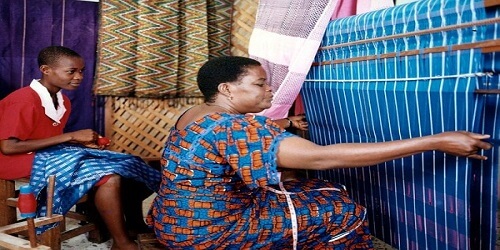
Akwete cloth as it is rightly named is a hand woven cloth produced by the people of Akwete – Ndoki in Abia State of Nigeria. Although some other communities around the region so participate in this craft of cloth weaving, but Akwete is the most renowned of these weaving communities. Its cloth is highly reputed for excellence that the name of the town was given to all textiles produced in the area.
Akwete cloth is woven entirely from cotton, in a continuous warp, and supplementary weft patterning by women using the broad vertical loom. Historically, hand spun cotton was the most common material used in the cloth but modern weavers both women and men use machine-produced cotton yarns and silken rayon threads of various colors from textile mills in Nigeria and abroad.
Dada Nwakata is the pioneer of the highly ornamented intricate weft patterns on Akwete cloth. She used imported cotton and silk (probably rayon) yarns. According to A. E. Afigbo, a renown Igbo historian in (1985), Dada Nwakata unravelled threads from an open woven cotton cloth locally known as acham, brought to the area through trade with the potoki (Portuguese) sometimes between the 14-16 centuries when the latter operated in the Bight of Biafra.
After studying the weave structures of the heavily ornamented cloth, Dada Nwakata copied them and secretly began to weave a new style of Akwete designs. The style of her weave structures were revealed after her death by a deaf and dumb friend who was the only person she permitted in her company when she wove her cloths.
However, Akwete cloth comes in different colours and designs. Some are in the patterns of red and black designs, interwoven in geometric patterns on the white ground which is favored by Igbo men. It is mainly used as a towel for bathing. The Akwete cloths, woven from sisal-hemp fibers are of coarse type, used by masqueraders, and by warriors as headgears, while those made from raffia fibers are used on religious occasions like the Ozo titleship, and for mourning by women.
But the most popular Akwete cloth is the type of cotton fabric woven from cotton fibers in colorful patterns; the weavers have much preference for bright and strong colour like red and yellow. Traditionally, the raw cotton fibers that surround and protect cotton seeds do undergo some processes before use, namely: First, ginning process, by which the cotton seeds are removed from the fibers by rolling a rod over the cotton ball.
Second, bowing process, which involves making cotton fibers fluffy by flicking the string of a small bow against them until they look like cotton wool. Third, spinning process, which is done by pulling the fibers into threads. Processing of the cotton fibers from the cotton seeds is not the same with that of the raffia fibers. Raffia as we know is the fibre from the fresh leaf of the palm tree.
The process of extracting fibre from the thorny raffia palm frond demands a special skill by the woman weaver. She first of all starts from the tip, the distal end by splitting it, and then gently pulls down to the inflorescence. Weaving as gender defined job: She dries the fibers in the sun or by the fire place to make them dry enough for use in weaving. Generally, it is women who process the raffia fibers or cotton fibers or any other kind of fibers for used in weaving.
The size of the Akwete fabric is what distinguishes it from other textiles made on vertical loom and it takes atleast three or more days to produce a standard length cloth (115cm wide x 1609cm long) with complex and intricate design. The length of the finished product is normally twice the height of the loom.
Ukwa East Local Government, therefore, is comprised of Asa and Ndoki people in Abia state with rich resources for traditional weaving that could serve as a souvenir for tourists. The hand crafted cloth,according to Dada Nwakata, the originator of the Akwete cloth in Akwete is called “Akuru” (something woven). Before Dada’s innovation and revolution to “Akuru”, Akwete were woven only as “Akwa mmiri” meaning Towel. Loom, the traditionalequipment used in the weaving is grown naturally in the area.
Raffia palm and back of palm trees – the palm species that does not bear palm fruit, only produce a milder palm wine called locally as “Nju” and is also used in the production. There are also other cultural attractions such as festivals, traditional dances showcasing Akwete wears. Beaches, Rivers and streams are vogue for tourist and needs to be repositioned for tourism development in the area and will complement the local weaving handcraft industry.
Banks in Abia
Brief History of Abia
Business and Economy
General and Teaching Hospitals
Hotels and Guest Houses
Abia State Ministries Agencies and Parastatals
Police Stations
Popular Markets
Restaurants, Bars and Night Clubs
Shopping Malls
Traditional Rulers
Arochukwu Cave
Azumini Blue River
National Museum of Colonial History, Aba
National War Museum, Umuahia
Brief History of Abia
Business and Economy
General and Teaching Hospitals
Hotels and Guest Houses
Abia State Ministries Agencies and Parastatals
Police Stations
Popular Markets
Restaurants, Bars and Night Clubs
Shopping Malls
Traditional Rulers
FESTIVALS and CARNIVALS
Iwaji FestivalTOURIST ATTRACTIONS
Akwete WeaversArochukwu Cave
Azumini Blue River
National Museum of Colonial History, Aba
National War Museum, Umuahia
Connect With Us
 |
 |
 |
 |
